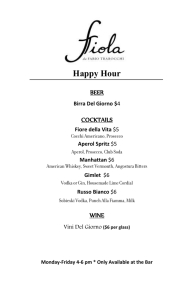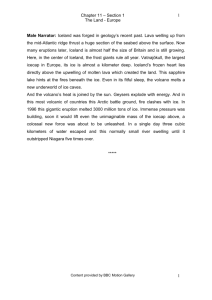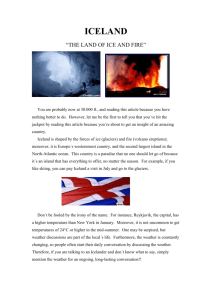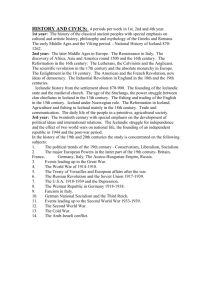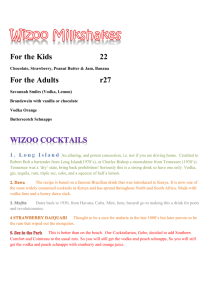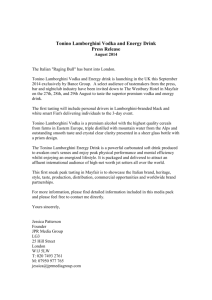The Worshipful Company of Distillers
advertisement
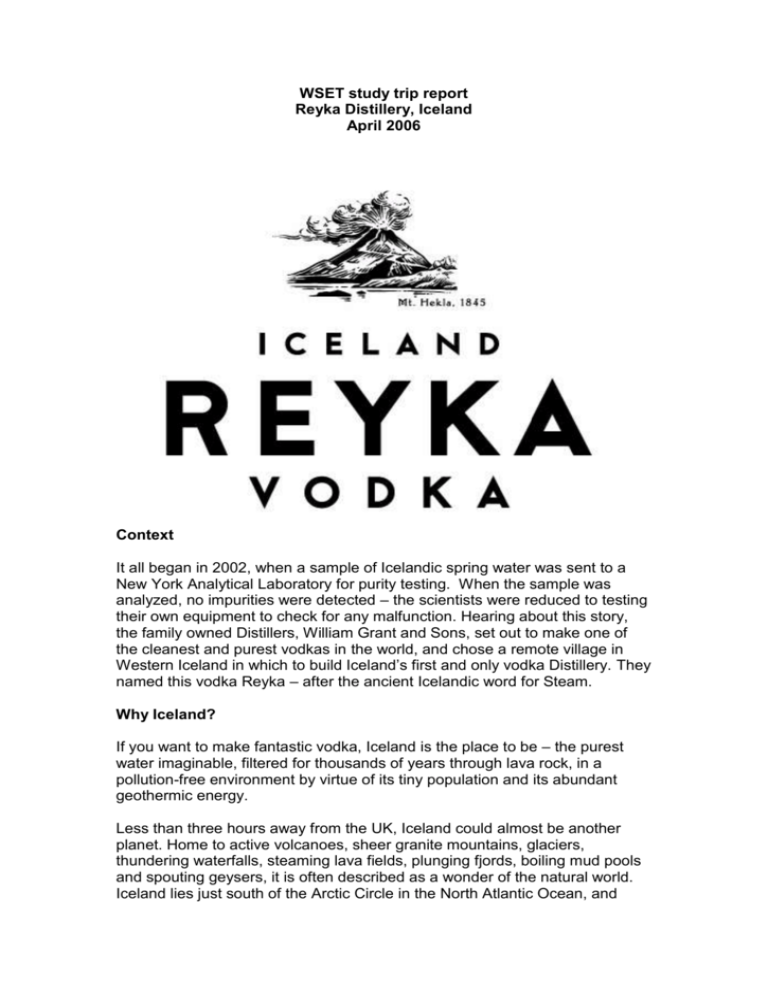
WSET study trip report Reyka Distillery, Iceland April 2006 Context It all began in 2002, when a sample of Icelandic spring water was sent to a New York Analytical Laboratory for purity testing. When the sample was analyzed, no impurities were detected – the scientists were reduced to testing their own equipment to check for any malfunction. Hearing about this story, the family owned Distillers, William Grant and Sons, set out to make one of the cleanest and purest vodkas in the world, and chose a remote village in Western Iceland in which to build Iceland’s first and only vodka Distillery. They named this vodka Reyka – after the ancient Icelandic word for Steam. Why Iceland? If you want to make fantastic vodka, Iceland is the place to be – the purest water imaginable, filtered for thousands of years through lava rock, in a pollution-free environment by virtue of its tiny population and its abundant geothermic energy. Less than three hours away from the UK, Iceland could almost be another planet. Home to active volcanoes, sheer granite mountains, glaciers, thundering waterfalls, steaming lava fields, plunging fjords, boiling mud pools and spouting geysers, it is often described as a wonder of the natural world. Iceland lies just south of the Arctic Circle in the North Atlantic Ocean, and covers an area of 103,000 sq. km, equivalent to the size of England. However, it is home to a mere 280,000 inhabitants, three fifths of whom live in the capital Reykjavik. Formed 16 to 20 million years ago by volcanic eruptions, it is seen as one of the youngest countries in Europe and one of the most volcanically active places on earth. Iceland straddles the Mid-Atlantic Ridge at the junction of the American and African plates, which are moving apart at a rate of an inch a year. The ridge is characterised by frequent earthquakes and a series of craters and hot springs. On average, there is volcanic activity about once every five years, the most spectacular of recent years being the Surtsey eruption on the seabed off the Vestmannaeyjar islands in 1963, when a new island formed 1.7 sq miles in size. Despite the volcanic activity, the island has been shaped by ice. The Vatnajukull glacier is over 3000 feet thick and covers some 3000 sq miles. It is not only the largest in Europe but larger than all of the others put together. Ice still covers over 10% of the island, and the natural springs fed by these glaciers provide some of the cleanest water on earth. The Reyka Distillery The Reyka distillery lies on the outskirts of Borgarnes, a village of some 2000 people lying 40 miles north of Reykjavik, close to the Snaefellsnes peninsula and the Langjokull glacier. Borgarnes is heated geothermally by the water from the hot water spring at Deildartunga. This is the largest water yielding hot spring in the world, giving off 180 litres of boiling water per second. This water provides heat for the town of Borgarnes and is used as the energy source in the production process for Reyka Vodka. Reyka Vodka is produced using a new Carter Head Still, specially made for the purpose in Scotland on behalf of William Grants & Sons. This type of still was developed in the 19th Century by the two Carter brothers who were originally employed by Aeneas Coffey. After learning their trade at the hands of the master, they left to start their own business of designing and manufacturing unique still designs. Originally, the Carter Head Still was developed to rectify crude spirit produced by the Coffey into spirit suitable for the production of gin and vodka. This style of still is used successfully within the spirit industry for the production of some leading brands of gin, but Reyka is the only vodka to use this type of still in its production. The Distillation Process Reyka Vodka is produced by re-distillation of high quality grain neutral spirit using a Carter Head Still. The source spirit is produced by an eight column distillation apparatus in Scotland and transported to Iceland in tanker. Reyka is distilled twice in total – by this stage, it is already so pure that the vodka would lose more in positive taste characteristics than it could ever gain in purity from additional distillation. Spirit, cold glacial water and feints from the previous distillation are mixed to give an alcohol concentration of 80% ABV. Experience has shown that this particular starting concentration increases the sensory quality of the ultimate spirit, by facilitating the concentration and removal of the trace low boiling compounds. The spirit charge is pumped to the Carter Head Still via a heat exchanger that uses geothermal energy from the world’s largest hot spring to preheat the spirit. The spirit temperature is raised by approximately 35ºC thus reducing the volume of steam required for the distillation. All energy used in the Reyka Vodka process is from renewable sources. The unique properties of the Carter Head Still lie in the complex arrangement within the neck of the still. The intricate maze of copper cones and pyramids jacketed by cooling water enables a high level of further purification of the grain neutral spirit to take place. A careful combination of heat and cooling water allow the spirit to be gently distilled. This ensures that any low boiling compounds with adverse sensory qualities are accumulated at the top of the still. These can then be removed and discarded from the still as the foreshots fraction. The Reyka Vodka vapour passes through the lyne arm of the still at a rate of approximately 300 litres per hour. It is then filtered through the botanics box containing pillow lava from the Vatnajokull glacier, and is condensed to liquid. Before reaching the spirits safe, the vodka undergoes further filtration as it passes through a lava basket containing basalt lava from Snaefellsnes. The inclusion of lava into the process sets Reyka apart from other vodkas: its heritage is truly Icelandic, raw materials being as old as the island itself. The Master Distiller, Kristmar Ollofson, uses his experience to judge when to start collecting the heart, mainly though nosing the distillate: the first 10 to 15 litres will contain traces of methanol, which has a distinctive odour and is discarded. The heart is collected at around 93% alcohol by volume, and cut off at 87%, before the feints start coming through the still. The spirit is diverted into the feints vessel and distillation continues until the alcohol concentration falls to zero. The still is switched off and the water remaining in the bottom of the still is discarded. The whole process takes 5 hours for each batch, and produces about 890 litres of distillate. Prior to bottling on site, the vodka is diluted to 40% ABV using water taken from the Grabrok spring located close to the Reyka Distillery. This spring is in a lava field that is 3600 to 4000 years old, providing the distillery with a source of pure water that, as can be seen from the table of results below, contains very low levels of dissolved solids. 900 Total Dissolved Solids (ppm) 800 700 600 500 400 300 200 100 0 GRABROK Spring VOLVIC EVIAN CRYSTAL GEYSIR VITTEL Source: The Good Water Guide, 2001 The original analysis for this water was carried out by the New York Analytical Laboratory who were so amazed at the results they found that they decided to recalibrate all of their equipment to convince themselves of the accuracy of the findings. This lack of impurities obviates the need for any further purification step prior to its use in Reyka Vodka. Reyka Vodka takes its heritage seriously, even to the point of experimenting with barley grown in Iceland with a view to including it in the production process. The harsh climate means that breeds of barley with necessary characteristics such as early maturing and short stems have been developed for the island. Sowing takes place in April with harvesting in late August through to the middle of September. In total some 10,000 tonnes of barley are produced annually on Iceland, mainly in the south but also in the west and north. Fields of barley can be seen very close to the Reyka distillery and grain from these fields may be used in future production of the pure Icelandic spirit. Conclusion A unique vodka made in a unique location – many thanks to the Worshipful Company of Distillers, the WSET, William Grants & Sons and First Drinks for making this experience possible.

